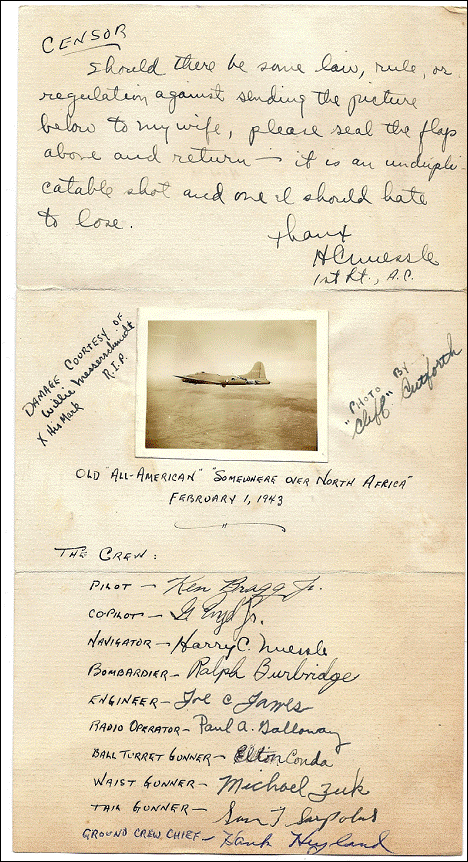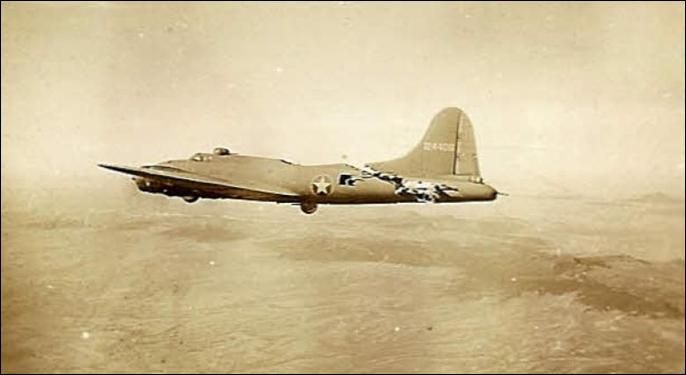
Posted on 09/02/2012 8:54:46 AM PDT by Windflier
WWII B-17 Survival Story

B-17 in 1943
A mid-air collision on February 1, 1943, between a B-17 and a German fighter over the Tunis dock area, became the subject of one of the most famous photographs of World War II. An enemy fighter attacking a 97th Bomb Group formation went out of control, probably with a wounded pilot then continued its crashing descent into the rear of the fuselage of a Fortress named All American, piloted by Lt. Kendrick R. Bragg, of the 414th Bomb Squadron. When it struck, the fighter broke apart, but left some pieces in the B-17. The left horizontal stabilizer of the Fortress and left elevator were completely torn away. The two right engines were out and one on the left had a serious oil pump leak. The vertical fin and the rudder had been damaged, the fuselage had been cut almost completely through connected only at two small parts of the frame and the radios, electrical and oxygen systems were damaged. There was also a hole in the top that was over 16 feet long and 4 feet wide at its widest and the split in the fuselage went all the way to the top gunners turret.
Although the tail actually bounced and swayed in the wind and twisted when the plane turned and all the control cables were severed, except one single elevator cable still worked, and the aircraft still flew - miraculously! The tail gunner was trapped because there was no floor connecting the tail to the rest of the plane. The waist and tail gunners used parts of the German fighter and their own parachute harnesses in an attempt to keep the tail from ripping off and the two sides of the fuselage from splitting apart. While the crew was trying to keep the bomber from coming apart, the pilot continued on his bomb run and released his bombs over the target.
When the bomb bay doors were opened, the wind turbulence was so great that it blew one of the waist gunners into the broken tail section. It took several minutes and four crew members to pass him ropes from parachutes and haul him back into the forward part of the plane. When they tried to do the same for the tail gunner, the tail began flapping so hard that it began to break off. The weight of the gunner was adding some stability to the tail section, so he went back to his position.
The turn back toward England had to be very slow to keep the tail from twisting off. They actually covered almost 70 miles to make the turn home. The bomber was so badly damaged that it was losing altitude and speed and was soon alone in the sky. For a brief time, two more Me-109 German fighters attacked the All American. Despite the extensive damage, all of the machine gunners were able to respond to these attacks and soon drove off the fighters. The two waist gunners stood up with their heads sticking out through the hole in the top of the fuselage to aim and fire their machine guns. The tail gunner had to shoot in short bursts because the recoil was actually causing the plane to turn.
Allied P-51 fighters intercepted the All American as it crossed over the Channel and took one of the pictures shown. They also radioed to the base describing that the empennage was waving like a fish tail and that the plane would not make it and to send out boats to rescue the crew when they bailed out. The fighters stayed with the Fortress taking hand signals from Lt. Bragg and relaying them to the base. Lt. Bragg signaled that 5 parachutes and the spare had been "used" so five of the crew could not bail out. He made the decision that if they could not bail out safely, then he would stay with the plane and land it.
Two and a half hours after being hit, the aircraft made its final turn to line up with the runway while it was still over 40 miles away. It descended into an emergency landing and a normal roll-out on its landing gear.
When the ambulance pulled alongside, it was waved off because not a single member of the crew had been injured. No one could believe that the aircraft could still fly in such a condition. The Fortress sat placidly until the crew all exited through the door in the fuselage and the tail gunner had climbed down a ladder, at which time the entire rear section of the aircraft collapsed onto the ground. The rugged old bird had done its job.








My Dad’s neighbor, in Syracuse, a few years older than Dad, enlisted, after Pearl. The story I was told; as a B-17 Top Gunner (position behind the cockpit), during one mission, he bent down to pick up his dropped cigarette. While he was bent over, the plexiglass dome was blown to bits. One of those cases where smoking doesn’t kill ;)

More B-17 eye candy here: Aluminum Overcast
I'd be willing to bet that he kept a piece of that broken plexiglas for good luck!
I sure hope so ! :)
I saw that pic when I was in grade school & the caption said that the ME-109 pilot was already dead before it hit the B-17.
But I also heard accounts of German pilots ramming B-17s and intending to survive, and did so.
And did the military archbishop of U.S. forces declare that if we were invaded, American fighter pilots who rammed enemy planes would not be committing suicide?

2ND Lt. Charlie Brown was a B-17F Flying Fortress pilot with the 379th Bomber Group at Kimbolton, England. His B-17F was called “Ye Olde Pub” and was in a terrible state, having been hit by flak and fighters. The compass was damaged and they were flying deeper over enemy territory instead of heading home to Kimbolton. Most of the tail & half of the stabilizer were gone.
After flying over an enemy airfield, a pilot named Franz Stigler was ordered to take off and shoot down the B-17F. When he got near the B-17, he could not believe his eyes. In his words, he “had never seen a plane in such a bad state”. The tail and rear section was severely damaged, and the tail gunner wounded. The top gunner was all over the top of the fuselage. The nose was smashed and there were holes everywhere.
Despite having ammunition, Franz flew to the side of the B-17 and looked at 2nd Lt. Charlie Brown, Lt. Brown was scared and struggling to control his damaged and bloodstained plane.
Aware that they had no idea where they were going, Franz waved at Charlie to turn 180 degrees. Franz escorted and guided the stricken plane to and slightly over the North Sea towards England. He then saluted Charlie Brown and turned away, back to Europe.
When Franz landed he told the C.O. that the plane had been shot down over the sea, and never told the truth to anybody. Charlie Brown and the remainder of his crew told all at their briefing, but were ordered never to talk about it.
More than 40 years later, Charlie Brown wanted to find the Luftwaffe pilot who saved the crew. After years of research, Franz was found. He had never talked about the incident, not even at postwar reunions.
They met in the USA at a 379th Bomber Group reunion, together with 25 people who are alive now - all because Franz never fired his guns that day.
Research shows that 2nd Lt. Charlie Brown lived in Seattle and Franz Stigler had moved to Vancouver, BC after the war. When they finally met, they discovered they had lived less than 200 miles apart for the past 50 years!
In his first letter to Brown, Stigler had written: "All these years, I wondered what happened to the B-17, did she make it or not?"
She made it, just barely. But why did the German not destroy his virtually defenseless enemy?
"I didn't have the heart to finish off those brave men," Stigler later said. "I flew beside them for a long time. They were trying desperately to get home and I was going to let them do it. I could not have shot at them. It would have been the same as shooting at a man in a parachute."
Sadly Franz Stigler passed away on 22 March 2008. Charlie Brown passed away on 24 November 2008.
Funny. I just posted the harrowing tale of the B-17, ‘Ye Old Pub’, and then come back to the thread and see that you posted the link. Great minds and all that :-)
So true.This bird was repaired and put back in service and you just cant do that to a lanc or a lib.
I skipped school for a week back in 76 to work on that very plane in griffin georgia.She had just been sold and I helped build a new wooden floor for her.I lost credit for that quarter of school but I found what I wanted to do for the rest of my life.Fair trade I think.I now manufacture new parts for B-17 restorations and loving it.
They had made so many runs by that time that the plane knew its way home.
Awesome. Did she retain her name and number?
Man.....now that's a dream job. I'm jealous :-)
NO, it said Email but I figured there was a location for the information.
I'm a conscientious Freeper. If I'd had a link I would have posted it.
Link is at post 46, courtesy of csmusaret.
That story apparently originates from Andy Rooney who claimed to have witnessed the incident during WWII at an airbase in England. It was dramatized in a show called Amazing Stories produced by Steven Spielberg.
I went on a tour of a B17 recently at an air museum. The most surprising thing to me was the narrow bridge/catwalk running through the bomb bay area that was the only way to get between the front and rear of the plane.
Here's a view of that narrow catwalk through the fuselage.

From below, in the bomb bay:


Disclaimer: Opinions posted on Free Republic are those of the individual posters and do not necessarily represent the opinion of Free Republic or its management. All materials posted herein are protected by copyright law and the exemption for fair use of copyrighted works.